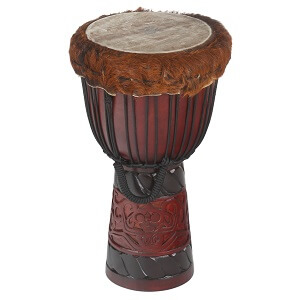Djembe
 The djembe is one of West Africa's best known instruments. This goblet-shaped drum is traditionally carved from a single piece of African hardwood and topped with an animal skin as a drumhead. In western understanding, the drum belongs to the membranophone class of instruments in the percussion family.
The djembe is one of West Africa's best known instruments. This goblet-shaped drum is traditionally carved from a single piece of African hardwood and topped with an animal skin as a drumhead. In western understanding, the drum belongs to the membranophone class of instruments in the percussion family.
Some say the name of the djembe came from the Bamana in Mali, who said "Anke dje, anke be" to call their people together, as the saying translates as "everyone gather together." "Dje" means gather and "be" means everyone, which gave the drum used in these calls to order its name. The Bamanakans' mythology tells of the original djembe, which was made of the hide of a giraffe-zebra hybrid called the gebraffe. There are at least a dozen stories of the history of the drum told by many master drummers. My master tells these stories and then steps back as even he, doesn't purport to know the real truth. In history, the Mandinka of Manden became the Malinke of Mali.
The djembe drum is most likely about 400-800 years old, and was created during the Malian Empire by the Mandé people. It spanned the modern-day countries of Senegal, southern Mauritania, Mali, northern Burkina Faso, western Niger, the Gambia, Guinea-Bissau, Guinea, the Ivory Coast and northern Ghana. The Mali Empire grew out of an area referred to by its contemporary inhabitants as Mande.